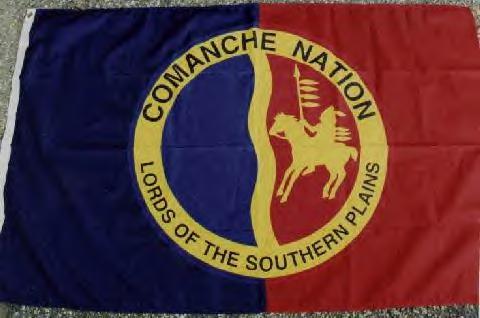|
|
Canku Ota |
|
|
(Many Paths) |
||
|
An Online Newsletter Celebrating Native America |
||
|
December 1, 2001 - Issue 50 |
||
|
|
||
|
Passing On Their Words Man Teaches Comanche |
||
|
by Jean Sims, Correspondent
-Times Record News-November 22, 2001
|
||
|
"I am called a 'Speaker' among the Comanche tribe, because I learned our language as a child, along with English, in my grandmother Mary Lena Ukannachappy's home," DeVenney said. "Now I teach the language to students who learn words mostly, because the language is not spoken in their homes," he said. The Comanche tribe in the 1800s were rounded up near Palo Duro Canyon in Texas and brought by the army to Ft. Sill near Lawton, Okla. From the reservation, the Comanche children were placed in Indian boarding schools, where they were severely disciplined for using their language. "This move from Texas into Oklahoma was the 'Comanche Trail of Tears' and the beginning of a movement to destroy the language and culture of our tribe," DeVenney said. "The boarding schools along with mixed marriages over the years were a major factor in the Comanche people not learning and speaking our language in their homes." DeVenney is fluent in his native language, and people began coming to him when he was a very young man asking him to come to their homes and teach them the language. He soon became a Speaker and today goes to schools and special groups to teach. DeVenney holds another honor; he is the historian for the Comanche Nation and travels through out the United States photographing American Indians as they are today. He also brings his collection of old photographs, as well as his work, putting on shows for organizations and people interested in Indian culture. "Sam is called an elder by many people because of the respect they have for him and his knowledge of Indian people from all tribes," said Susan Whitehorse Johnson, a teacher at Walters Middle School, where he recently visited. The Comanche tribe were once members of the Shoshone Nation located in Idaho, before they began drifting toward the southwest part of the country. They came down in bands at different times, and DeVenney said that this is the reason there are different bands and differences in the language within the tribe today. The Comanche people acquired horses from the Spanish, and took the horses back north to the Shoshone and other tribes. "Sam took a group of us, both students and adults to Idaho where we visited the Shoshone a couple of years ago," Johnson said. DeVenney said the Comanche language is difficult because it is a changing language. At one time when a person died their name was never spoken again, which made many of the words dead to the language. "There are many non-Indians interested in studying our culture and our history which has been well preserved through the years," DeVenney said. "I have enjoyed many of my students who pick up the language better than some of my Native American students. I have even had some students from other countries that have done well, like my German students," he said.
|
||||||||||
|
|
||
|
|
||
| Canku Ota is a free Newsletter celebrating Native America, its traditions and accomplishments . We do not provide subscriber or visitor names to anyone. Some articles presented in Canku Ota may contain copyright material. We have received appropriate permissions for republishing any articles. Material appearing here is distributed without profit or monetary gain to those who have expressed an interest. This is in accordance with Title 17 U.S.C. section 107. | ||
|
Canku Ota is a copyright © 2000, 2001, 2002 of Vicki Lockard and Paul Barry. |
||
|
|
|
|
|
The "Canku Ota - A Newsletter Celebrating Native America" web site and its design is the |
||
|
Copyright © 1999, 2000, 2001, 2002 of Paul C. Barry. |
||
|
All Rights Reserved. |
||

 WALTERS,
Okla. - Sam "Per kay uan ard" DeVenney, teaches Native American
culture and the Comanche language to both American Indians and non-Indians
throughout southwest Oklahoma and Texas.
WALTERS,
Okla. - Sam "Per kay uan ard" DeVenney, teaches Native American
culture and the Comanche language to both American Indians and non-Indians
throughout southwest Oklahoma and Texas.